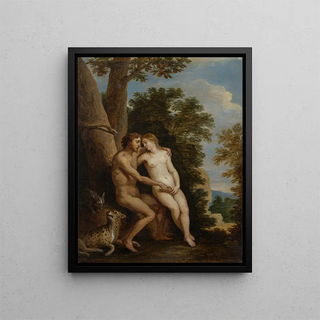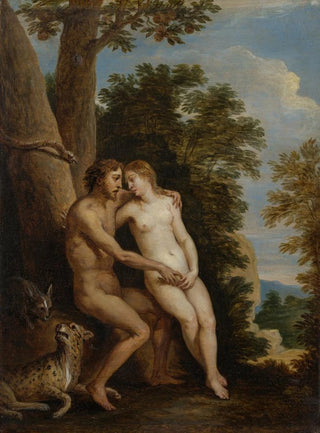Art print | Adam and Eve in Paradise - David Teniers the Younger


View from behind

Frame (optional)
The artwork "Adam and Eve in Paradise" by David Teniers the Younger transports viewers to the heart of a lush Garden of Eden, where beauty and innocence blend with the purity of the first humans. This painting, emblematic of 17th-century Flemish painting, evokes an atmosphere of serenity and contemplation. Through a vibrant color palette and harmonious composition, Teniers invites us to explore themes of creation, nature, and the human condition. While a mythological representation, the piece resonates deeply with universal emotions, making this art print an essential element for anyone looking to enrich their living space with an artistic touch.
Style and uniqueness of the work
Teniers' style is characterized by meticulous attention to detail and an ability to capture light in an almost magical way. In "Adam and Eve in Paradise," every leaf, every sunbeam filtering through the foliage is rendered with precision that showcases the artist's skill. The figures of Adam and Eve are depicted with natural grace, their postures and expressions conveying an almost palpable innocence. The composition is carefully balanced, with natural elements surrounding the characters, emphasizing their place within this idyllic world. This painting does not merely depict a biblical scene; it also evokes a sense of nostalgia for a bygone era, a time when harmony between man and nature seemed unshakeable. The richness of textures and colors creates an immersive visual experience that transports the viewer to this mythical Eden.
The artist and his influence
David Teniers the Younger is one of the most influential artists of his time, known for his genre scenes and landscapes. Born in 1610 in Antwerp, he established himself through his exceptional talent and his ability to capture everyday life with remarkable precision. Teniers also played a crucial role in spreading Flemish art across Europe, influencing many contemporary and future artists. His mastery of light and color, along with his narrative approach, has

Matte finish

View from behind

Frame (optional)
The artwork "Adam and Eve in Paradise" by David Teniers the Younger transports viewers to the heart of a lush Garden of Eden, where beauty and innocence blend with the purity of the first humans. This painting, emblematic of 17th-century Flemish painting, evokes an atmosphere of serenity and contemplation. Through a vibrant color palette and harmonious composition, Teniers invites us to explore themes of creation, nature, and the human condition. While a mythological representation, the piece resonates deeply with universal emotions, making this art print an essential element for anyone looking to enrich their living space with an artistic touch.
Style and uniqueness of the work
Teniers' style is characterized by meticulous attention to detail and an ability to capture light in an almost magical way. In "Adam and Eve in Paradise," every leaf, every sunbeam filtering through the foliage is rendered with precision that showcases the artist's skill. The figures of Adam and Eve are depicted with natural grace, their postures and expressions conveying an almost palpable innocence. The composition is carefully balanced, with natural elements surrounding the characters, emphasizing their place within this idyllic world. This painting does not merely depict a biblical scene; it also evokes a sense of nostalgia for a bygone era, a time when harmony between man and nature seemed unshakeable. The richness of textures and colors creates an immersive visual experience that transports the viewer to this mythical Eden.
The artist and his influence
David Teniers the Younger is one of the most influential artists of his time, known for his genre scenes and landscapes. Born in 1610 in Antwerp, he established himself through his exceptional talent and his ability to capture everyday life with remarkable precision. Teniers also played a crucial role in spreading Flemish art across Europe, influencing many contemporary and future artists. His mastery of light and color, along with his narrative approach, has






